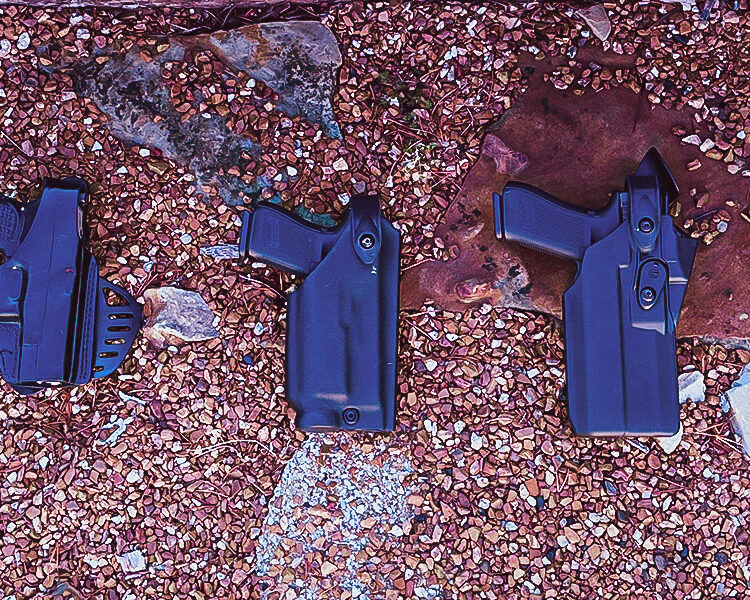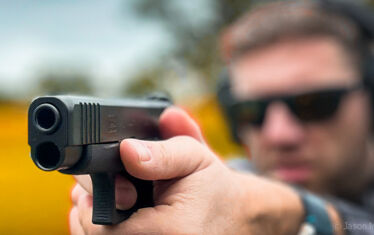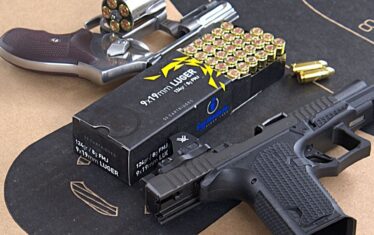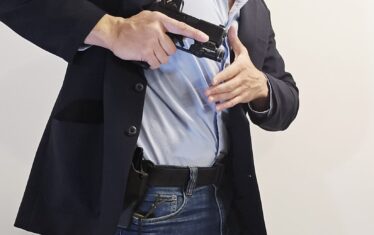Do you have a holster with a security mechanism? If not, it’s something you should strongly consider. After working nearly two decades in law enforcement, I’ve seen firsthand why it matters.
The quality of your holster is just as important as the quality of the gun you choose to carry every day. And by quality, I’m not just talking about the finish on the holster, the material it’s made of, and the price tag. I’m talking about the built-in system that keeps your gun secure when it matters.
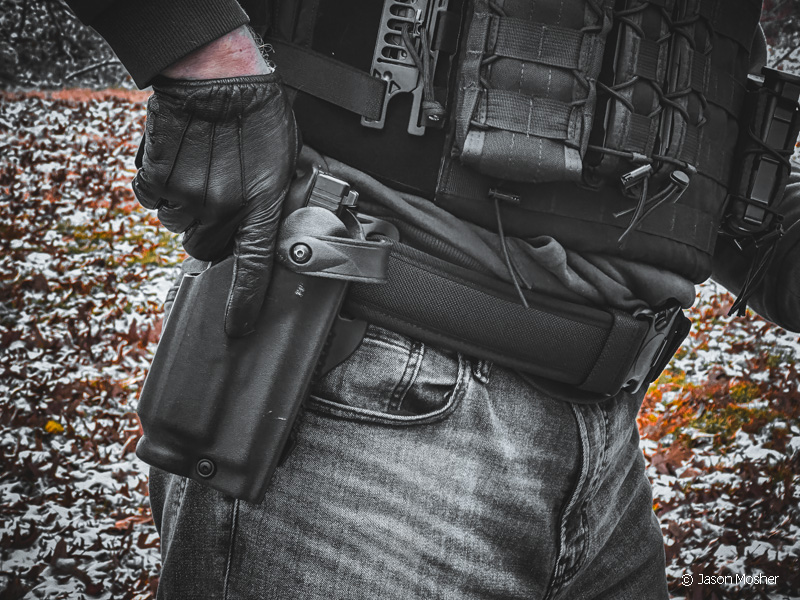
Over the years I’ve seen guns fall from their holsters in a variety of circumstances. I know of a hunter whose gun fell from his holster while climbing over a fence. Another time, an older gentleman was chased by an aggressive dog and lost his firearm while running. And on several occasions, there have been people who lost their gun during a scuffle that escalated before they realized they might need it.
It’s easy to think of holster security mechanisms as a law enforcement feature only. But cops are not the only ones who need high-quality holsters designed to secure the gun until it’s drawn.
Safariland stands out among holster manufacturers as the first company to create an entire retention system (Levels 1-4). They have multiple security mechanisms for a redundant safety feature that makes sure the gun stays in the holster until drawn.
Here is a quick rundown of the most popular types of security mechanisms offered by Safariland.
ALS: Automatic Locking System
The Automatic Locking System is one of the most common features found on Safariland holsters. As the name implies, this feature locks the gun in place automatically when it is holstered. The ALS system is built into the side of the holster and locks the gun from all directions when holstered.
A thumb release (also called a lever) is located at the top of the holster. When you grip the firearm to draw it, your thumb naturally rests on this lever. Push back on the lever as you draw the gun and the lock is released, allowing the gun to move freely from the holster.

To achieve true retention, a holster needs to be part of a Duty-Rated system, which we will talk about in a separate article. On Duty Rated holsters, the ALS system is rated as a level One retention. But even on holsters that aren’t Duty Rated, the ALS feature is a great way to help keep the firearm secure.
Many of the duty/tactical holsters offered by Safariland also feature an ALS guard. This guard is basically a shield that covers the thumb release from the front. For someone else to take your gun out of the holster, they would need to press the thumb release. The guard restricts access from the front of the holster without interfering with access for the person wearing it.
SLS: Self-Locking System
So, what’s the difference between The Automatic Locking System and the Self-Locking System (SLS)? It’s not another name for the same function if that’s what you were thinking.
The SLS is another locking feature, but it works differently and many times in conjunction with the ALS system. On the SLS system, a rotating hood covers the top of the gun to keep it in the holster. This may look somewhat like the leather strap you are used to seeing on leather holsters.
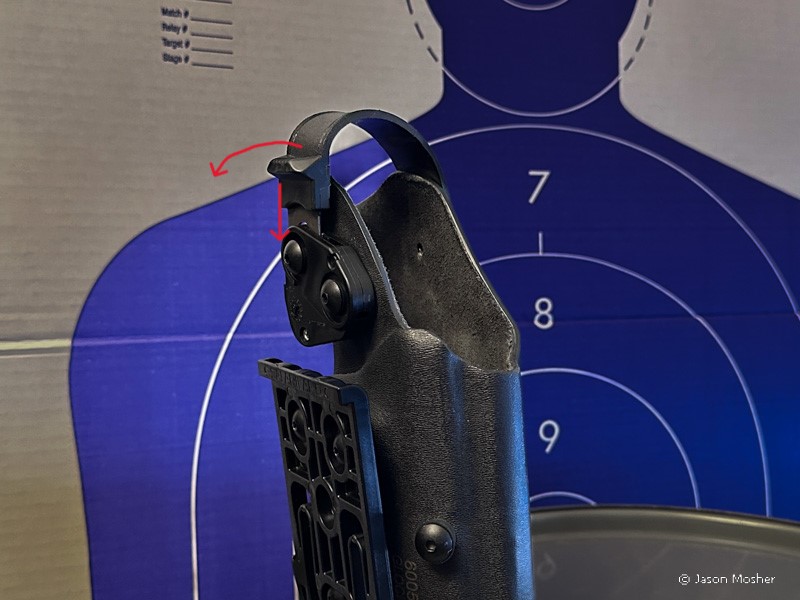
In this case, however, the “strap” is connected on both sides and rotates forward to allow the gun to be drawn. To draw the gun, you must push down on a lever and then forward. This requires two motions which gives it a Level 2 retention on duty-rated holsters. Just like the ALS system, the motion of pressing down and forward feels natural and is easy to do. When you holster the gun and pull the hood back, it covers the top of the gun and locks it in place.
Many holsters, like the ones I wear for duty, have both the ALS and SLS systems on them. When both systems are in place, push down and forward to rotate the hood downward, then pull back on the thumb release as you draw the gun. Because the ALS is a Level 1 retention and the SLS is a Level 2, you get a Level 3 retention when used on duty-rated holsters.
GLS: Grip Locking System
Found on many PRO-FIT holsters, the GLS is an automatic locking system that is released when you grip the gun. Just under the grip, near the trigger guard area is a flat lever. It is pressed by your middle finger when gripping the gun to draw it. You can’t really grip the gun without pressing the lever so it’s the easiest and most natural of them all.
This is a great system for low-profile holsters where you need concealment combined with security.
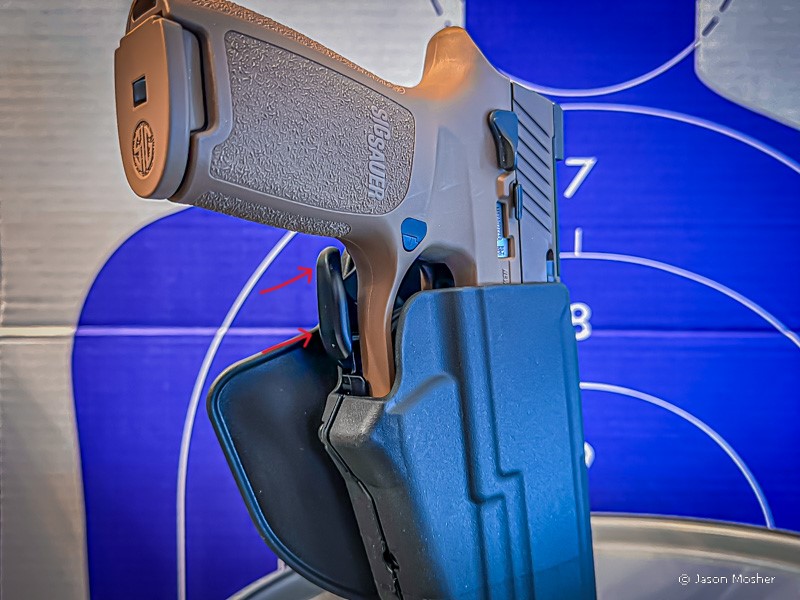
I use a 578 GLS PRO-FIT concealment holster to carry my Sig M17 9mm pistol. Because of its design, I can wear a full-size handgun like the M17 in a concealed manner. This holster can be worn with a paddle or belt attachment, and it keeps the gun close to your side. This is about as concealed as you can get with an OWB holster. I rarely carry large handguns IWB, so this is my go-to holster when I need a full-size gun in a concealable holster.
Thumb Snap Feature
This is by far the most common feature found on leather holsters. A leather strap extends from the outside of the holster and goes over the top of the gun. It snaps on the other side using a traditional metal snap.
Most holster manufacturers place a piece of metal to the snap that extends out a short distance. This provides support for the thumb to push against when un-snaping the holster. Jon Bianchi first created this design back in the early 1960’s. If that name sounds familiar, you may have heard it from the Bianchi Leather holster company.
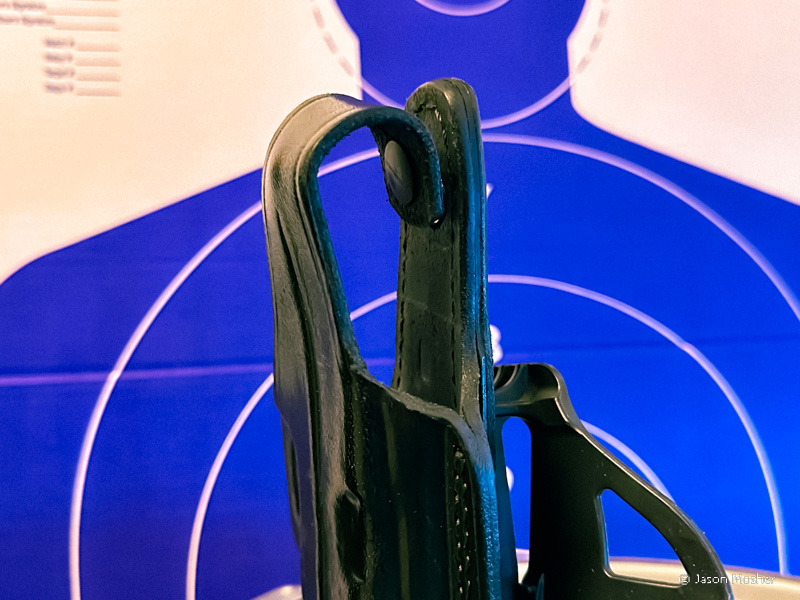
While a thumb break is not as secure as a modern holster with ALS or SLS systems, it does provide some security. Many people (like me) still love the looks of a classic leather holster. Having a thumb snap feature will help keep the gun secure until you intend to draw it.
Members of law enforcement and the military rarely use leather holsters with thumb snaps these days, but I use one off-duty from time to time.
Trigger Guard Detent
A trigger guard detent is most often used with IWB holsters. Because of their size, an IWB holster may not have a locking system to keep the gun in place. The trigger guard detent sticks out just enough to put pressure on the trigger guard area of the gun as you holster it. Once you push the gun in far enough, you will hear it “snap” in place.
While this isn’t a locking feature, it is a passive security feature that uses friction. A screw on the side of the holster allows you to adjust the amount of friction placed on the gun.

One example of this is the Safariland Species holster for my Ruger Max 9. The holster is molded specifically for this gun, which gives it a perfect fit once holstered all the way. Before the gun is fully seated in the holster you can feel some resistance, but once it clears the trigger guard, it fits like a glove. It’s not a lock, but it does take the same amount of resistance to draw it making it perfect for IWB concealed carry.
Summary
Selecting the right holster for your gun is not always an easy task. When you look for one, I recommend checking out Safariland holsters for all your holster needs. They focus on safety, security, and durability with all their holsters. Cops around the country choose them because they make the best law enforcement and military-grade holsters out there. Safariland has expanded to the civilian market as well, and now that same quality is available for your daily carry.
Regardless of the type of holster you want, there is a good chance Safariland makes one for it. Choose how you want to carry your gun and then select a holster with the security mechanisms you desire. One easy way to see all the available options is to use Safariland’s holster finder. It will help you see every holster available for a specific gun.
Other companies offer retention systems on their holsters. But what sets Safariland apart is the rigorous testing each security mechanism and holster are subjected to. If there is any failure at all, they start over. This means you get a top-notch holster at a reasonable price, and it will function as expected.
In my career, I’ve seen a Safariland holster save a deputy’s life when a suspect attempted to remove it from the holster. The bad guy couldn’t get the deputy’s gun out and that deputy is alive and well today. If you plan to carry a gun, buy a quality holster to carry it in.





